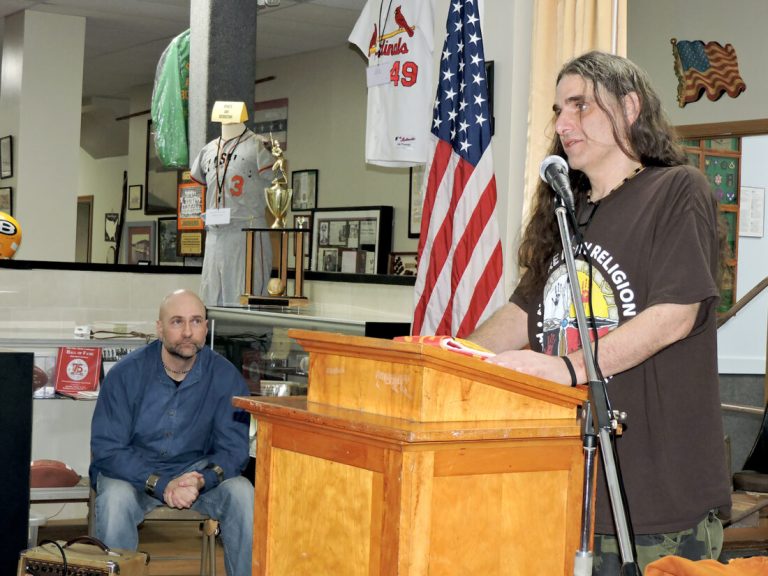
A DIFFERENT PERSPECTIVE – Aaron Curry, left, and Christian Allen share music and other aspects of Native American culture Saturday at the Brooke County Historical Museum and Culture Center. –Warren Scott
WELLSBURG — As special guests Saturday at the Brooke County Historical Museum and Cultural Center, Christian Allen and Aaron Carey offered a perspective on the Native Americans who lived in the Ohio Valley many years before the first European immigrants arrived in this area.
Christian Allen, a Greensburg, Pa., resident of Shawnee descent, said it's common at such gatherings for Native Americans to deliver “words that should come before anything else.”
Also known as a Thanksgiving speech, they express gratitude for many things, including family – which includes the many creatures with whom they share the land – Mother Earth, water, “the blood of Mother Earth”; And all its plant life.
The latter includes plants that have grown wild and those that have been domesticated, such as corn and sunflowers, Allen said.
He said sunflowers were originally clusters of small buds that resembled the large head they are known as today, producing delicious seeds and oil used in cooking. While corn was raised from wild grasses.
“It was genetically modified, but it was done naturally through reproduction over many years,” Allen said.
“As a chef, I could talk for days about all the things you can make with corn,” he said.
He added that thanks are also given to the sun, stars and other celestial bodies.
In addition to being the basis for various tales, the constellations served as a guide at night, Allen said.
“On a clear night, we may get confused, but we are never lost,” he said.
Allen added that thunder was seen as a protector rather than something to fear.
“The earth needs to cleanse itself with weather,” he said, and the thunder is very similar to the sign of modern road construction.
Allen noted that tomatoes and chocolate were produced by indigenous people in North and South America before being brought back to Europe, where they became staples in many cuisines and a part of many cultures to this day.
The Native American influence extends beyond food, he said.
Allen noted that Native Americans are behind the names of many places, including the Mingo tribe who settled Ohio in the mid-1700s.
He added that the Constitution of the Iroquois Confederacy, which united five Native American nations, was among the influences on the United States Constitution, which brought together 13 independent former colonies.
The Shawnee were among many Native Americans transported by the U.S. government to reservations in the West, and the influence of their culture has been almost forgotten, Allen noted.
“For many years, mainstream culture viewed local culture as backward and ridiculous,” he said.
But Allen said Native Americans believe each person has a responsibility to be good stewards of the land, which existed before them and will remain after they are gone.
“If you're borrowing something from someone, you have to make sure it's in good working order when you return it to them,” he said.
Language is a big part of an individual's culture, with its values influencing the way things are said, Allen said.
He said the number of Shawnee who could speak the indigenous language dwindled to 18 until Glenna Wallace, leader of the Eastern Shawnee tribe in Oklahoma; Others created the Shawnee Language Immersion program in 2020, from which 168 students graduated last year.
Before Allen's talk, Carey performed music drawn from or inspired by Native American culture on guitar and flute.
Curry, a Wellsburg resident and music teacher at Bethany College, said he and Allen met as heavy metal rock performers but found they shared an interest in their Native American heritage.
Vicki Gallagher, president of the museum's volunteer board, said Allen and Carey have presented programs there in the past that received a great response and were happy to have it back.
She encouraged attendees to suggest ideas for future programs.
An open house at the museum planned by the Wellsburg Chamber of Commerce last week was canceled due to recent flooding, but there are plans to reschedule it, fellow board member Bobby Elliott said.
Last weekend saw the museum open for the warmer months, resuming its normal working hours from one in the afternoon until five in the evening every Thursday, Friday and Sunday. Visits can be arranged during other hours by calling (304) 737-4080.

